
The Pirate Surgeon's Quarters: 1 2 3 4 5 6 7 8 9 10 11 12 Next>>
The Pirate Surgeon's Quarters in the Golden Age of Piracy, Page 8
Location of the Surgeon on the Orlop
"In Merchant-men the Chyurgeons Place is usually in the Cable Teer [Tier] between Decks, but in Men of War 'tis in the Hold abaft of [behind] the Mast, between that and the Bulk-Head of the Cockpit from side to side." (John Moyle, The Sea Chirurgeon, p. 49)
From Moyle's description, we learn that the surgeon's place would either be in the Cockpit or the Cable-tier, depending on the type of ship. Let's look at each more closely.
Location of the Surgeon on the Orlop: The Cockpit
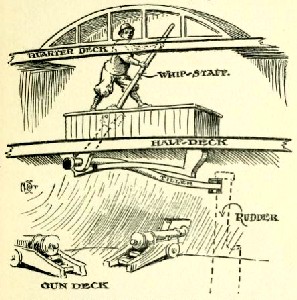
The Operation of a Whipstaff, from
Ships and Ways of
Other Days by E. Keble Chatterton, p. 189 (1913)
The term 'cockpit' is an interesting one that for many people brings to mind the area at the front of a commercial airplane or atop a military plane where the pilot sits amidst a forest of controls. While it basically served the same function during the golden age of the pirates as it does on airplanes, it was located in a very different place.
The main controls for a sailing vessel were on an exposed deck of the ship where the steersman could see where he was going. While some ships may have had a ship's wheel to control the vessel during this time - the sort we're used to seeing in the movies - most would have been controlled with a whipstaff.1 However, this wasn't what was called the cockpit - that was located in the bowels of the ship on the orlop deck.
The cockpit housed the secondary directional controls for the ship, to be used when steering the vessel when it was unsafe to be topside. Nathaniel Uring reported that in an engagement between his packet boat [a boat delivering mail] and French privateers, the action during the battle "obliged me to order the People to steer in the Cabbin [where the cockpit was], we having an Iron Tiller there for that purpose"2. (As a side note, an iron tiller seems like an odd choice for a tiller given the corrosiveness of salt water.)
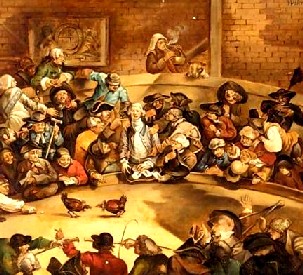
Artist: William Hogarth
The Cock-Fight (mid 18th century)
Curiously, the origin of the word 'cockpit' was in the late 16th century in reference to a fighting pit for roosters.3 Sometime in the 17th century, it came to be associated with sailing vessels. This may have been a reference to the dimly lit, sunken location of the secondary controls, reminding the men of a dusky gambling den of battling fowl.
When a vessel had a cockpit, that was where the surgeon was stationed during battle. As mentioned in the discussion about the orlop deck, the surgeon had to be put some place protected. With this in mind, surgeons on naval vessels and ships-of-war were usually put in the cockpit. In fact, by 1787 a maritime glossary by Marmaduke Stalkartt referred to the cockpit only as "a place on the after-platform where the wounded are taken to be dressed", making no reference whatsoever to secondary controls.4
We should again keep the looseness of terminology during this era in mind when considering how 'cockpit' might have been applied to a vessel. Technically, there are no period references to it in the sea-surgeon's manuals directly from the
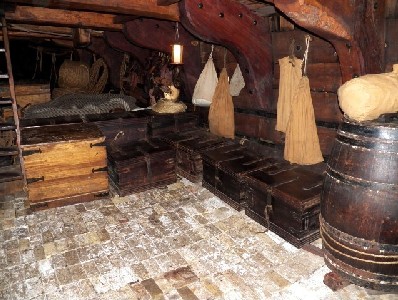
Photographer: Michael Lamonica
The Cockpit and Cable-Tier (where the rope is) of the Duyfken Replica
(based
on a 1606 ship). Note ballast bricks that make up the floor.
golden age of pirates. John Moyle's quote, which leads off this section, is from his book The Sea Chirurgeon which was first printed in 1673 -17 years before the golden age of piracy (roughly defined as 1690-1725). John Atkins mentions it in his book The Navy Surgeon which was first printed in 1742 - 17 years after the golden age.5 Being book ended by two such sources, we can safely state that the term was in use during the time period in question - at least on war vessels.
It is also possible that whereever the surgeon happened to be operating on the orlop deck could have been referred to as the cockpit based on the fact that term came to be associated primarily with him, although this can't be stated with certainty.
The cockpit would be located near the rear of a vessel, behind the main mast, as is indicated in the drawing of the orlop deck of the Mercury below. Note that the Mercury does not show a cockpit in the schematic. It is a small boat and had it been built, it may not have had an alternative steering mechanism. So this diagram is primarily for reference. Indeed, the two stern chaser cannons sit where the alternate steering mechanism would most likely be, so the cockpit area specifically refers to the surgeon's quarters on this vessel.
 Artist and Designer: William Pace - Used with Permission The Orlop Deck of the Mercury with the location of the Cockpit indicated in read and the cable-tier indicated in blue. |
When the cockpit was not serving as the site of the emergency controls or as the surgeon's operating theatre, it was used as living space by the men on a ship.6 Here they hung their hammocks, lived and sometimes even ate. This would be especially true on smaller vessels such as the Mercury where there were only two decks - one inside and one out - typical for a sloop.
The surgeon's mates and assistants would have their quarters here as well. Tobias Smollett, a former sea-surgeon, wrote a fictional parody called The Adventures of Roderick Random which follows the adventures of a naval sea-surgeon. While the book clearly contains exaggerated
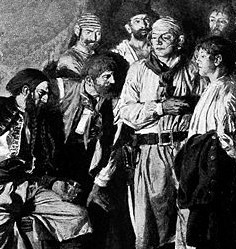
Artist: Howard Pyle
Suspicious Pirates from The Story of
Jack
Ballister's Fortunes, p. 121 (1894)
characters, Smollet clearly drew upon his real-life experiences in setting up the environment Roderick inhabited. In one scene, the mates and assistants are hanging out in their bunks when the jealous ship's surgeon "took the resolution of listening to our conversation, by hiding himself behind the canvass that surrounded our berth."7
Stephen R. Bown explains that the surgeon's mates lived "in a six-foot-square canvas enclosure in the cockpit on the orlop deck"8 on a naval vessel. On a pirate ship the mates would not have been likely to have the privacy of the canvas enclosure, however. The pirates would have wanted them to be in the open.
People who want to prove that pirates were egalitarians sometimes point to the fact that they knocked down walls and cabins in the ship, suggesting everyone was equal. While this may have been true, it also prevented forced men from scheming and planning revolts and escapes in secret. Captain George Roberts, a captive of Bartholomew Roberts, explains how three of Roberts' crew met him early in the morning on the main deck, always looking over the shoulder in fear that "the Company... would think they held a secret Correspondance with me, which was against one of their Articles, it being punishable by Death"9. So the pirates would certainly not want to provide the forced surgeon and his mates with any opportunities to be out of sight by giving them a canvas enclosure.
1 Benerson Little, The Sea Rover's Practice: Pirate Tactics and Techniques, 1630-1730, p. 54; 2 Nathaniel Uring, A history of the voyages and travels of Capt. Nathaniel Uring, with a new draught of the Bay of Honduras, p. 97; 3 cockpit, etymonline.com, gathered 11/3/12; 4 Marmaduke Stalkartt, Naval Architecture, p. 207; 5 John Atkins, The Navy Surgeon, p. 148; 6 John J. Keevil, Medicine and the Navy 1200-1900: Volume II – 1640-1714, P. 167; 7 Tobias Smollett, The Adventures of Roderick Random, p. 167; Bown, Stephen R., Scurvy: How a Surgeon, a Mariner, and a Gentleman Solved the Greatest Medieval Mystery of the Age of Sail, p. 88; 9 George Roberts, The four years voyages of Capt. George Roberts, p. 61;
Location of the Surgeon on the Orlop: The Cable-Tier
John Moyle's comment at the top of the page explains that merchant vessels put the surgeon in the cable tier rather than the cockpit. This might have been because many merchant ships didn't have a cockpit. Such craft were not built for warfare, so a secondary set of controls might not be needed. It may also have been because merchants didn't want the expense of a second set of controls or that the vessel was small enough not to need them. Baron Gerard Van Swieten notes that "[i]f the ship be small, and there is no cock pit, or such as you have not room to perform your operations in, you must, as near the after hatchway as is convenient, have some cask removed out (if there be not height enough for you to stand upright on the platform) that you may have a place of eight, ten, or twelve feet square, to receive and dress your wounded men, and from thence to hand them to their beds"1. Whatever the case, Moyle is definitive on this point.
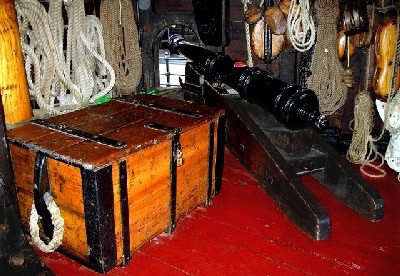
Photographer: Martin Addison
Cable Tier (and cannon) on the Golden Hinde Replica in London
As can be seen in the diagram of the Mercury in the previous section (above), the cable tier was forward of the main mast.. It was where the cables (or ropes as we call them) were coiled and stored. The London Encyclopaedia tells us that "[t]he greater part of the said [orlop] deck is... used for stowing and coiling the cables"2 giving a hint about its size.
Naturally, this would also depend on the size of the orlop deck, which in turn depended on the size of the ship. John Masefield expands upon the description of the cable tier noting that it contained "dark, capacious racks, in which the cables were coiled, by candlelight, when the ship weighed her anchor."3
Little else is said about the cable tiers. This may be due in part to the fact that many of the books written for sea surgeons were written with naval vessels in mind, where the surgeon normally resided in the cockpit. It may also be that other writers didn't adhere quite as strictly to terminology as Moyle and just referred to any place on the ship where the surgeon set up shop as the cockpit. Whatever the case, the cable tiers do not seem to have been of much interest and little was written about their role in the ship's surgeon's life.
1 Baron Gerard Van Swieten, The Diseases Incident To Armies, With The Method Of Cure, 1776 Translation of 1758 Original, p. 131-2; 2 The London Encyclopaedia, or Universal Dictionary of Science, Art, Literature, and Practical Mechanics, "Ship-Building" Volume 20, edited by Thomas Curtis, p. 224; 3 John Masefield, Sea Life in Nelson's Time, 1905, p. 274

